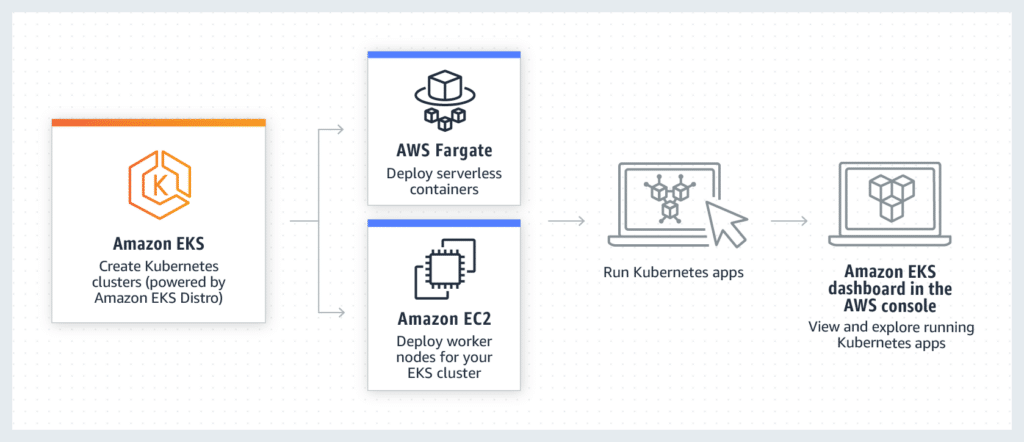Are you ready to unlock the true power of Kubernetes for your business? Look no further than Amazon EKS. This managed service makes it easier than ever to benefit from the scalability and efficiency of Kubernetes – so you have all the tools you need to optimize your containerized applications. With EKS, you can seamlessly deploy, manage, and scale your containers, all while taking advantage of the robust infrastructure and services provided by Amazon Web Services.
Table of Contents
By leveraging Amazon EKS, you can eliminate the complexities of setting up and managing your own Kubernetes cluster. Instead, focus your time and resources on building and improving your applications. Say goodbye to the hassle of infrastructure management and hello to a streamlined deployment process.
Understanding Kubernetes and its Benefits
Kubernetes, often abbreviated as K8s, is an open-source container orchestration platform that automates the deployment, scaling, and management of containerized applications. Its origins trace back to Google, where it was developed to address the challenges of running large-scale applications in containers. Today, Kubernetes has become the de facto standard for container orchestration, owing to its key benefits:
- Automatic scaling: Kubernetes can automatically scale applications based on demand, ensuring that resources are optimally utilized.
- Self-healing: Kubernetes can detect when a container or a node fails and will reschedule or restart containers as needed.
- Service discovery and load balancing: Kubernetes provides built-in tools for service discovery, allowing containers to communicate with each other seamlessly.
- Rollouts and rollbacks: Deploy new versions of your application without downtime and roll back to a previous version if needed.
The Power of Scalability in EKS
Amazon EKS takes Kubernetes scalability to a new level. Built on the vast infrastructure of Amazon Web Services, EKS ensures that your applications can handle any amount of traffic, from a few requests per minute to millions per second. With its automated scaling capabilities, Amazon EKS adjusts resources in real-time, ensuring optimal performance without wastage.
Efficiency and Cost Savings with Amazon EKS
One of the standout features of Amazon EKS is its cost-efficiency. By automatically scaling resources based on demand, EKS ensures that you only pay for what you use. This eliminates the need for over-provisioning resources and results in significant cost savings. Furthermore, with AWS’s pricing model, businesses can better predict their monthly expenses and optimize their budgets.
Key Features and Capabilities of Amazon EKS
Amazon EKS is not just another managed Kubernetes service; it’s a solution tailored for both the AWS cloud and on-premises data centers. Here’s a closer look at its standout features:
- Integrated Developer Tools: EKS offers seamless integration with a range of AWS developer tools, from AWS CodeBuild to AWS CodeDeploy, streamlining your development and deployment processes.
- Security and Networking: Beyond the basic security of Kubernetes, EKS is fortified with AWS’s networking and security services. It’s integrated with AWS Identity and Access Management (IAM), ensuring fine-grained access controls and robust security measures.
- Hybrid Deployments: One of the unique strengths of EKS is its flexibility in deployment. Whether you’re looking to deploy in the cloud or on-premises, EKS has you covered. For on-premises deployments, EKS provides a consistent and fully supported Kubernetes solution. This can be deployed on AWS Outposts, virtual machines, or even bare metal servers, offering unparalleled flexibility.
- Automated Management in the Cloud: In the AWS cloud, EKS takes the reins, automatically managing the availability and scalability of the Kubernetes control plane nodes. These nodes are pivotal, handling tasks like scheduling containers, ensuring application availability, and storing cluster data. With EKS, you’re freed from the intricacies of these tasks, allowing you to focus on what truly matters – your applications.
- Integrated Logging and Monitoring: Stay in the know with EKS’s integration with Amazon CloudWatch. This provides real-time insights into your applications, ensuring you’re always on top of performance metrics and potential issues.
Getting Started with EKS
Starting with Amazon EKS is straightforward. After setting up an AWS account, navigate to the EKS dashboard and create a new Kubernetes cluster. AWS provides detailed documentation and tutorials to guide you through the entire process, from configuring your cluster to deploying your first application.
Best Practices for Deploying Applications with Amazon EKS
- Use Helm charts: Helm is a package manager for Kubernetes that simplifies deployment.
- Monitor resource usage: Regularly review metrics to ensure optimal performance.
- Implement CI/CD: Use AWS developer tools to automate your deployment pipeline.
- Stay updated: Regularly update your EKS clusters to benefit from the latest features and security patches.
Visualizing EKS Deployments
Running Amazon EKS in The Cloud
Harness the full power of AWS’s cloud infrastructure with EKS. This diagram illustrates how EKS seamlessly integrates with AWS services, ensuring optimal performance, scalability, and security for your containerized applications.

Run Amazon EKS on AWS Outposts
Dive into the hybrid cloud experience with EKS on AWS Outposts. The following diagram showcases how EKS extends its capabilities to on-premises environments, providing a consistent Kubernetes experience while leveraging AWS’s robust infrastructure.

Run Amazon EKS Anywhere
Amazon EKS’s flexibility shines through its ability to run virtually anywhere. This diagram highlights the deployment of EKS on various platforms, from virtual machines to bare metal servers, ensuring you have the freedom to deploy as per your business needs.

Monitoring and Managing Your Amazon EKS Clusters
With EKS, monitoring and management become a breeze. Use Amazon CloudWatch to monitor metrics, set alarms, and automate reactions to specific events. Furthermore, AWS offers tools like AWS X-Ray for tracing and AWS Config for configuration management, ensuring that your EKS clusters are always in optimal condition.
Conclusion: Harnessing the Power of Kubernetes with Amazon EKS
In today’s digital age, businesses need agile and scalable solutions to stay competitive. EKS, with its integration of Kubernetes, offers precisely that. By leveraging EKS, businesses can focus on what truly matters – innovating and delivering value to their customers, while AWS takes care of the underlying infrastructure. Dive into the world of EKS and transform your business’s digital journey.






